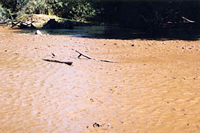Sedimentation of Waterways

Erosion of soils along riverbanks, results in various materials being suspended in the water column (suspended solids) or deposited over the streambed as sediment. Rivers always carry some suspended sediment but continual low flows may result in sediments being dropped before it can be carried out to sea. Sedimentation of the channel can also occur, under normal flow conditions, if abnormal amounts of material are being eroded from the banks.
Floods move sediment along the river but it is often dropped in the channel as flow decreases or, into the estuary, as has occurred in the Glenelg and Snowy Rivers.
The main problem from sedimentation is that it fills in the deeper areas of the river, changing the natural structure of pools and riffles to one of an even depth. It also covers the natural substrate with sand or silt. The river becomes a shallow, fast-flowing waterway with an even depth and a sand bed. The normal variety of different types of substrate material, various water velocities and water depths, and the different cover sites used by biota such as logs, boulders and gutters along the banks, are lost.
There is now only one habitat instead of the many different habitats present in a natural river. The result is that every species of aquatic biota and age class of each species, including fish, has lost some particular habitat necessary for their survival. Each individual uses different habitats at different periods of their life cycle and even during their daily activities. For example fish rest during the day in areas with a preferred water depth, a specific range of water velocity and in some shelter area that shades them from direct vertical view. This can be deep water, or provided by the structure of the channel, or instream debris. During feeding activities, they may move into shallower, faster-water areas with gravel and rubble substrate to feed.
This variety of habitat, essential for their survival, is lost when sedimentation occurs. Some more sedentary biota such as certain species of macroinvertebrates can only live in habitats such as gravel and rubble in riffles.
They will die if this is covered by sand and the species will be lost from that location. Fish may be able to move somewhere else but sedimentation can bury the areas, such as aquatic vegetation and gravel/rubble, which produce their food, or even destroy their spawning sites. The new sand beds now become one of the most unproductive substrates for food production and provide no opportunities for survival or hatching of spawned eggs.
Sedimentation also forces juvenile fish from their areas of shelter in the riffles, out into areas with little cover where they are exposed to predators. Pools which provide areas of permanent habitat and refuge for larger-sized fish during low flow events, are lost or reduced in extent. Less fish survive the summer resulting in fewer large fish for anglers to catch. Sedimentation may cause many other adverse effects such as, direct death of fish from clogging of their gills, turbid water reducing their ability to find food, or long term effects from poor water quality and pollution, resulting in stunted growth rates and increased mortality rates.
The shallow water may be occupied by vegetation that could not establish when water depths were greater. Water temperature may increase, particularly if the normal shade provided by riparian vegetation is lost. Fish with very specific habitat requirements will be lost perhaps to be replaced by introduced species, better able to survive the degraded conditions.
Sedimentation is a major problem in many Victorian rivers. It results from erosion of the banks into the river even at moderate flows. Erosion is accelerated if the natural riparian vegetation that binds and holds the soil in the bank has been removed. This breakdown of the soil is accelerated by stock, or even people, continually walking down to the water's edge. The need to stop excessive bank erosion and further sedimentation is now well accepted by the community. Farmers are urged to fence-off riverbanks and control access by stock. The State Government is funding research, education and replanting of riverbanks with native vegetation.
Once the banks are stabilised the amount of sediment entering the river will be reduced to a normal level that the natural flow regime can cope with. In many regulated rivers, such as the Glenelg, the natural flow regime has been lost and flows are now considerably less than normal. Unless flows can be increased, such as is now occurring in the Snowy River, it will take a long time for these rivers to restore themselves to a natural condition, with a variety of habitats and biota. A river can restore channel form including pools and riffles and clean substrates through the natural action of flowing water. This not only restores instream habitats and therefore more and larger fish for anglers but also increases the amount of water in the channel which is available to farmers for offstream use.
Anglers can assist this whole process in a practical way by not disturbing banks when fishing and also by not digging for bait close to the bank. Avoid trampling vegetation or clearing it from areas along the water edge where you decide to fish. Once the first step to reduce bank erosion, and therefore sedimentation, has been achieved, the next more difficult requirement is to increase particularly summer flow in the regulated rivers.
